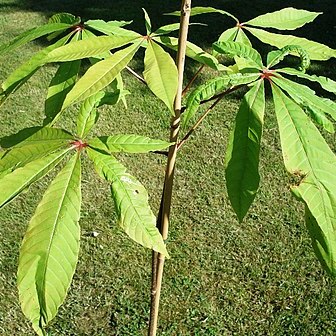Trees to 32 m tall, to 0.6 m d.b.h. Branchlets glabrous, subglabrous, or puberulent when young. Petiole 8-30 cm, glabrous, subglabrous, or puberulent; leaf blade 5-9-foliolate; petiolules 0.3-1.5 cm (leaflets rarely subsessile), glabrous, subglabrous, or sparsely puberulent and dark glandular when young; leaflet blades oblong-lanceolate to oblong-oblanceolate, rarely lanceolate to oblanceolate or narrowly so, (7-)12-35(-42) × (3-)5-18 cm, abaxially glabrous, or puberulent or pilose on veins when young, base cuneate or broadly so or rounded, margin crenulate to serrulate, apex acuminate to caudate; lateral veins in 17-30 pairs. Inflorescence pale yellow puberulent; peduncle 7-13 cm; thyrse cylindric, (22-)27-45 cm, 5-14 cm wide at base; branches 2-7 cm, 3-11-flowered; pedicels 3-7 mm. Flowers fragrant. Calyx 4-8 mm, abaxially gray or pale yellowish gray puberulent or finely gray velutinous. Petals 4, white or pale yellow, with purple or brown spots, sometimes orange toward base or claw reddish, unequal, 2 spatulate to oblong and 2 oblong-obovate or obovate, 13-22 × 3-7 mm, abaxially gray puberulent or velutinous. Stamens 5-7, 18-40 mm; filament glabrous; anther 1.5-3 mm. Style glabrous, subglabrous, sparsely puberulent, or tomentose. Capsule yellowish brown, ovoid to obovoid, subglobose, or depressed globose, 4.5-5 × 3-7.5 cm, dotted but smooth; pericarp 1.5-2 mm thick after drying. Seed usually 1, brown, globose, subglobose, or depressed globose, 3-7 cm in diam.; hilum white, occupying ca. 1/2 (rarely ca. 1/3) of seed. Fl. (Jan-)Feb-May, fr. Jun-Nov.
More
A tree. It grows 32 m tall. The trunk is 60 cm across. The leaves have 5-9 leaflets. These are 12-35 cm long by 5-18 cm wide. There can be teeth along the edge. The flowers are in groups of 3-11 flowers and they have a scent. The petals are white or yellow. The fruit is a capsule that is oval and 5 cm long by 3-8 cm wide. There is usually one seed.

